Management Accounting: A Comprehensive Guide for General Engineers Ltd
VerifiedAdded on 2024/05/31
|15
|2617
|56
AI Summary
This report provides a comprehensive overview of management accounting principles and practices, tailored specifically for General Engineers Ltd. It covers key topics such as cost-based pricing, marginal costing, budgeting, benchmarking, and strategic planning tools. The report aims to equip managers with the knowledge and insights needed to make informed financial decisions and drive business success.
Contribute Materials
Your contribution can guide someone’s learning journey. Share your
documents today.
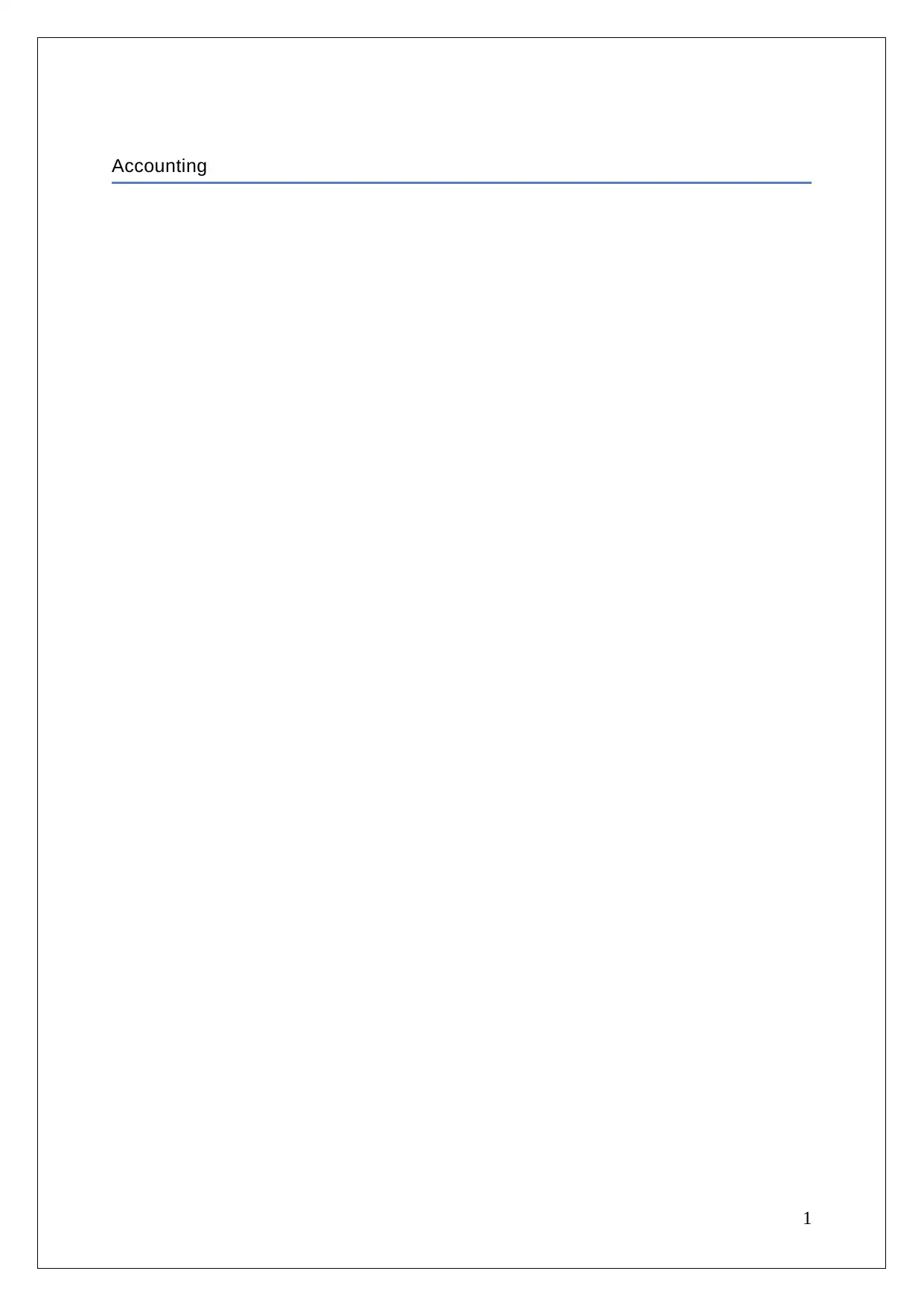
Accounting
1
1
Secure Best Marks with AI Grader
Need help grading? Try our AI Grader for instant feedback on your assignments.
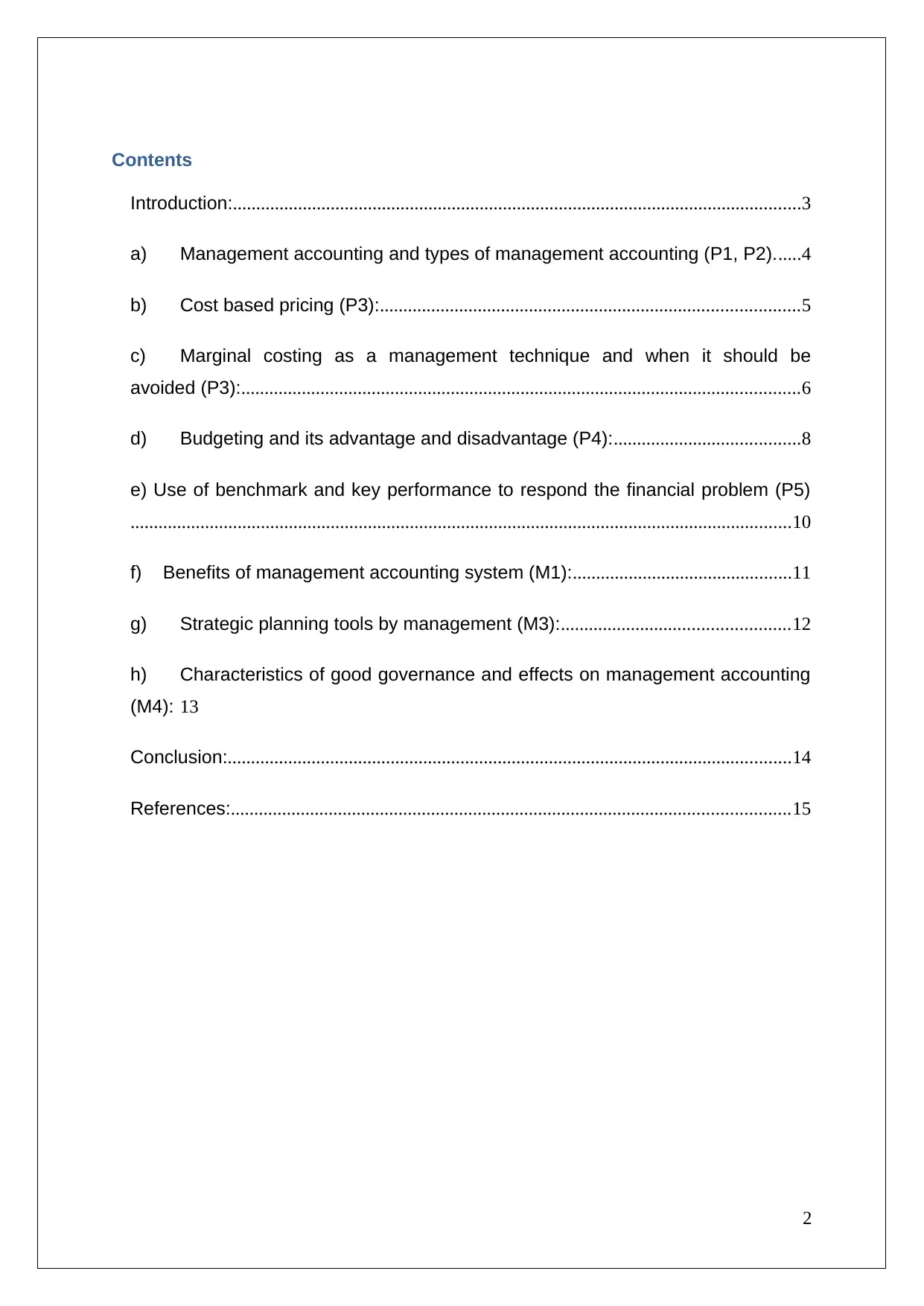
Contents
Introduction:..........................................................................................................................3
a) Management accounting and types of management accounting (P1, P2)......4
b) Cost based pricing (P3):..........................................................................................5
c) Marginal costing as a management technique and when it should be
avoided (P3):........................................................................................................................6
d) Budgeting and its advantage and disadvantage (P4):........................................8
e) Use of benchmark and key performance to respond the financial problem (P5)
..............................................................................................................................................10
f) Benefits of management accounting system (M1):...............................................11
g) Strategic planning tools by management (M3):.................................................12
h) Characteristics of good governance and effects on management accounting
(M4): 13
Conclusion:.........................................................................................................................14
References:........................................................................................................................15
2
Introduction:..........................................................................................................................3
a) Management accounting and types of management accounting (P1, P2)......4
b) Cost based pricing (P3):..........................................................................................5
c) Marginal costing as a management technique and when it should be
avoided (P3):........................................................................................................................6
d) Budgeting and its advantage and disadvantage (P4):........................................8
e) Use of benchmark and key performance to respond the financial problem (P5)
..............................................................................................................................................10
f) Benefits of management accounting system (M1):...............................................11
g) Strategic planning tools by management (M3):.................................................12
h) Characteristics of good governance and effects on management accounting
(M4): 13
Conclusion:.........................................................................................................................14
References:........................................................................................................................15
2
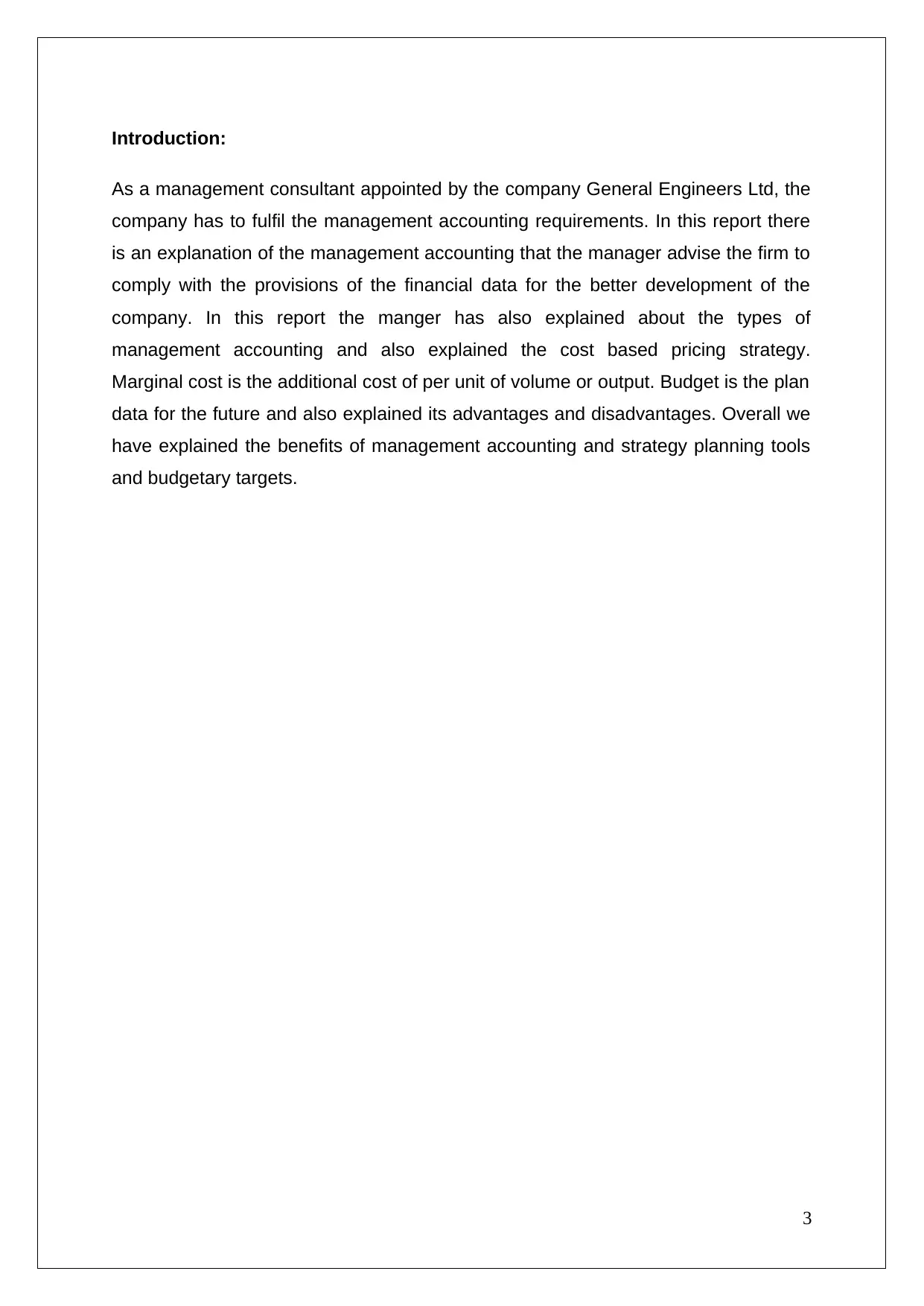
Introduction:
As a management consultant appointed by the company General Engineers Ltd, the
company has to fulfil the management accounting requirements. In this report there
is an explanation of the management accounting that the manager advise the firm to
comply with the provisions of the financial data for the better development of the
company. In this report the manger has also explained about the types of
management accounting and also explained the cost based pricing strategy.
Marginal cost is the additional cost of per unit of volume or output. Budget is the plan
data for the future and also explained its advantages and disadvantages. Overall we
have explained the benefits of management accounting and strategy planning tools
and budgetary targets.
3
As a management consultant appointed by the company General Engineers Ltd, the
company has to fulfil the management accounting requirements. In this report there
is an explanation of the management accounting that the manager advise the firm to
comply with the provisions of the financial data for the better development of the
company. In this report the manger has also explained about the types of
management accounting and also explained the cost based pricing strategy.
Marginal cost is the additional cost of per unit of volume or output. Budget is the plan
data for the future and also explained its advantages and disadvantages. Overall we
have explained the benefits of management accounting and strategy planning tools
and budgetary targets.
3
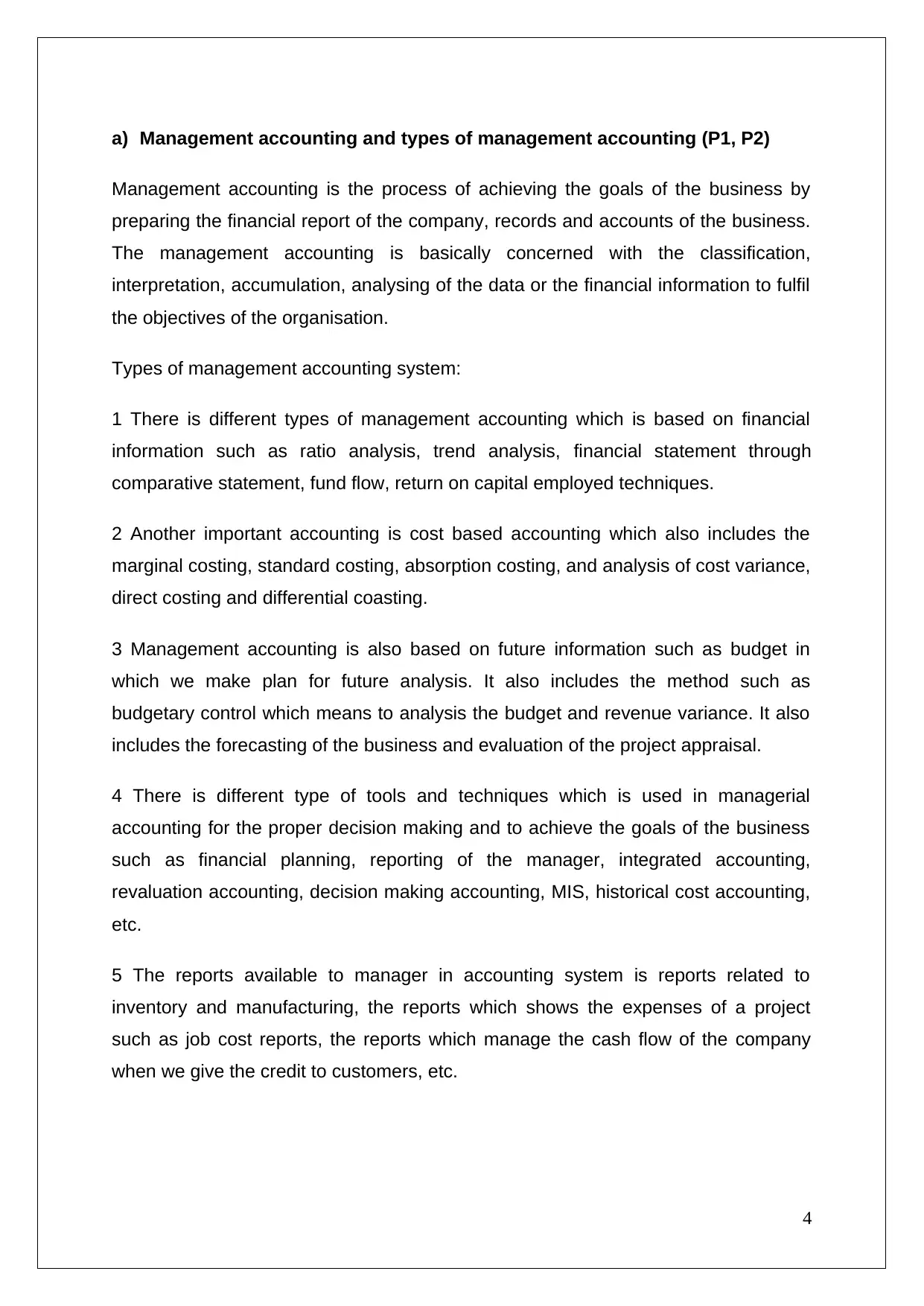
a) Management accounting and types of management accounting (P1, P2)
Management accounting is the process of achieving the goals of the business by
preparing the financial report of the company, records and accounts of the business.
The management accounting is basically concerned with the classification,
interpretation, accumulation, analysing of the data or the financial information to fulfil
the objectives of the organisation.
Types of management accounting system:
1 There is different types of management accounting which is based on financial
information such as ratio analysis, trend analysis, financial statement through
comparative statement, fund flow, return on capital employed techniques.
2 Another important accounting is cost based accounting which also includes the
marginal costing, standard costing, absorption costing, and analysis of cost variance,
direct costing and differential coasting.
3 Management accounting is also based on future information such as budget in
which we make plan for future analysis. It also includes the method such as
budgetary control which means to analysis the budget and revenue variance. It also
includes the forecasting of the business and evaluation of the project appraisal.
4 There is different type of tools and techniques which is used in managerial
accounting for the proper decision making and to achieve the goals of the business
such as financial planning, reporting of the manager, integrated accounting,
revaluation accounting, decision making accounting, MIS, historical cost accounting,
etc.
5 The reports available to manager in accounting system is reports related to
inventory and manufacturing, the reports which shows the expenses of a project
such as job cost reports, the reports which manage the cash flow of the company
when we give the credit to customers, etc.
4
Management accounting is the process of achieving the goals of the business by
preparing the financial report of the company, records and accounts of the business.
The management accounting is basically concerned with the classification,
interpretation, accumulation, analysing of the data or the financial information to fulfil
the objectives of the organisation.
Types of management accounting system:
1 There is different types of management accounting which is based on financial
information such as ratio analysis, trend analysis, financial statement through
comparative statement, fund flow, return on capital employed techniques.
2 Another important accounting is cost based accounting which also includes the
marginal costing, standard costing, absorption costing, and analysis of cost variance,
direct costing and differential coasting.
3 Management accounting is also based on future information such as budget in
which we make plan for future analysis. It also includes the method such as
budgetary control which means to analysis the budget and revenue variance. It also
includes the forecasting of the business and evaluation of the project appraisal.
4 There is different type of tools and techniques which is used in managerial
accounting for the proper decision making and to achieve the goals of the business
such as financial planning, reporting of the manager, integrated accounting,
revaluation accounting, decision making accounting, MIS, historical cost accounting,
etc.
5 The reports available to manager in accounting system is reports related to
inventory and manufacturing, the reports which shows the expenses of a project
such as job cost reports, the reports which manage the cash flow of the company
when we give the credit to customers, etc.
4
Secure Best Marks with AI Grader
Need help grading? Try our AI Grader for instant feedback on your assignments.
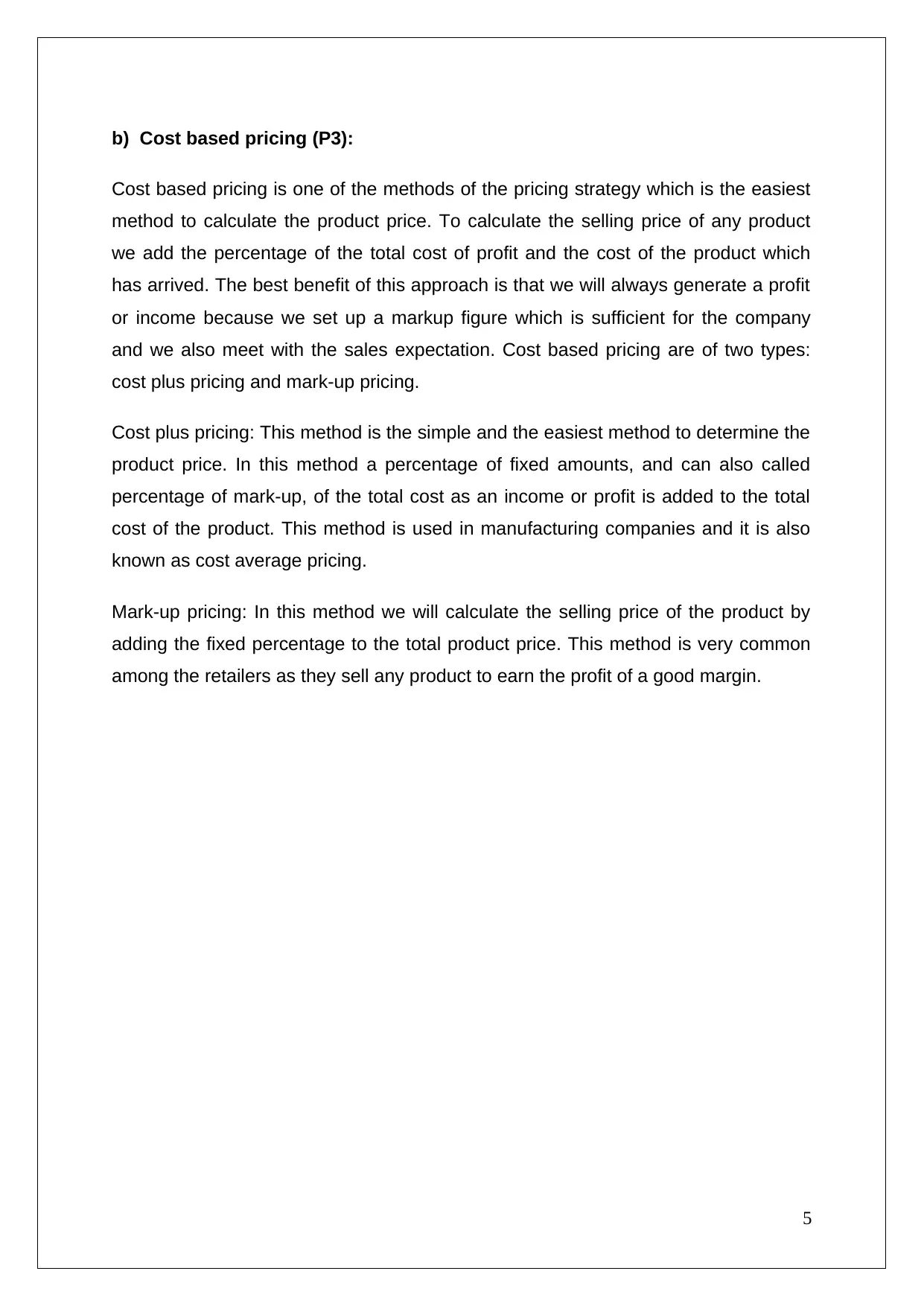
b) Cost based pricing (P3):
Cost based pricing is one of the methods of the pricing strategy which is the easiest
method to calculate the product price. To calculate the selling price of any product
we add the percentage of the total cost of profit and the cost of the product which
has arrived. The best benefit of this approach is that we will always generate a profit
or income because we set up a markup figure which is sufficient for the company
and we also meet with the sales expectation. Cost based pricing are of two types:
cost plus pricing and mark-up pricing.
Cost plus pricing: This method is the simple and the easiest method to determine the
product price. In this method a percentage of fixed amounts, and can also called
percentage of mark-up, of the total cost as an income or profit is added to the total
cost of the product. This method is used in manufacturing companies and it is also
known as cost average pricing.
Mark-up pricing: In this method we will calculate the selling price of the product by
adding the fixed percentage to the total product price. This method is very common
among the retailers as they sell any product to earn the profit of a good margin.
5
Cost based pricing is one of the methods of the pricing strategy which is the easiest
method to calculate the product price. To calculate the selling price of any product
we add the percentage of the total cost of profit and the cost of the product which
has arrived. The best benefit of this approach is that we will always generate a profit
or income because we set up a markup figure which is sufficient for the company
and we also meet with the sales expectation. Cost based pricing are of two types:
cost plus pricing and mark-up pricing.
Cost plus pricing: This method is the simple and the easiest method to determine the
product price. In this method a percentage of fixed amounts, and can also called
percentage of mark-up, of the total cost as an income or profit is added to the total
cost of the product. This method is used in manufacturing companies and it is also
known as cost average pricing.
Mark-up pricing: In this method we will calculate the selling price of the product by
adding the fixed percentage to the total product price. This method is very common
among the retailers as they sell any product to earn the profit of a good margin.
5
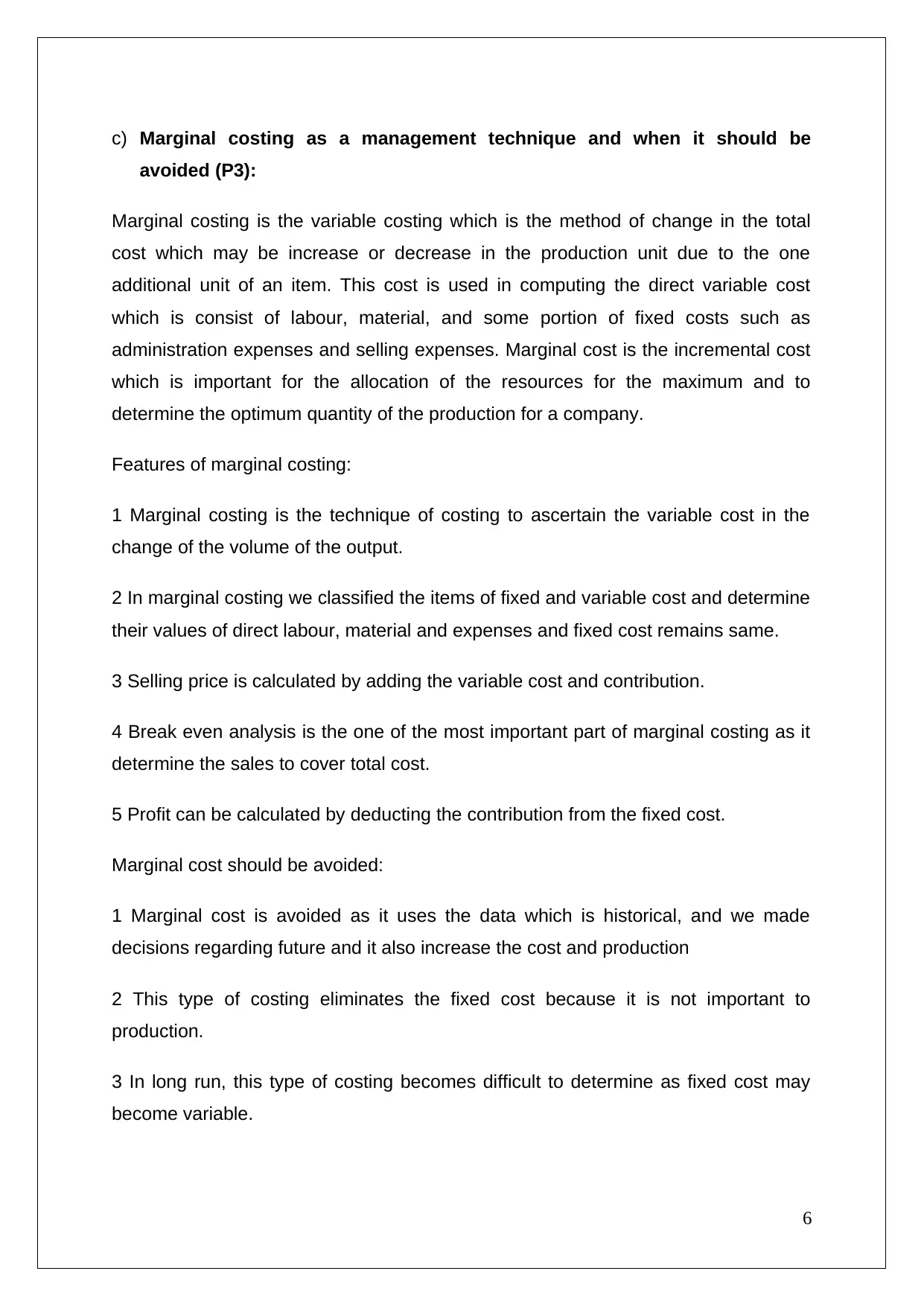
c) Marginal costing as a management technique and when it should be
avoided (P3):
Marginal costing is the variable costing which is the method of change in the total
cost which may be increase or decrease in the production unit due to the one
additional unit of an item. This cost is used in computing the direct variable cost
which is consist of labour, material, and some portion of fixed costs such as
administration expenses and selling expenses. Marginal cost is the incremental cost
which is important for the allocation of the resources for the maximum and to
determine the optimum quantity of the production for a company.
Features of marginal costing:
1 Marginal costing is the technique of costing to ascertain the variable cost in the
change of the volume of the output.
2 In marginal costing we classified the items of fixed and variable cost and determine
their values of direct labour, material and expenses and fixed cost remains same.
3 Selling price is calculated by adding the variable cost and contribution.
4 Break even analysis is the one of the most important part of marginal costing as it
determine the sales to cover total cost.
5 Profit can be calculated by deducting the contribution from the fixed cost.
Marginal cost should be avoided:
1 Marginal cost is avoided as it uses the data which is historical, and we made
decisions regarding future and it also increase the cost and production
2 This type of costing eliminates the fixed cost because it is not important to
production.
3 In long run, this type of costing becomes difficult to determine as fixed cost may
become variable.
6
avoided (P3):
Marginal costing is the variable costing which is the method of change in the total
cost which may be increase or decrease in the production unit due to the one
additional unit of an item. This cost is used in computing the direct variable cost
which is consist of labour, material, and some portion of fixed costs such as
administration expenses and selling expenses. Marginal cost is the incremental cost
which is important for the allocation of the resources for the maximum and to
determine the optimum quantity of the production for a company.
Features of marginal costing:
1 Marginal costing is the technique of costing to ascertain the variable cost in the
change of the volume of the output.
2 In marginal costing we classified the items of fixed and variable cost and determine
their values of direct labour, material and expenses and fixed cost remains same.
3 Selling price is calculated by adding the variable cost and contribution.
4 Break even analysis is the one of the most important part of marginal costing as it
determine the sales to cover total cost.
5 Profit can be calculated by deducting the contribution from the fixed cost.
Marginal cost should be avoided:
1 Marginal cost is avoided as it uses the data which is historical, and we made
decisions regarding future and it also increase the cost and production
2 This type of costing eliminates the fixed cost because it is not important to
production.
3 In long run, this type of costing becomes difficult to determine as fixed cost may
become variable.
6
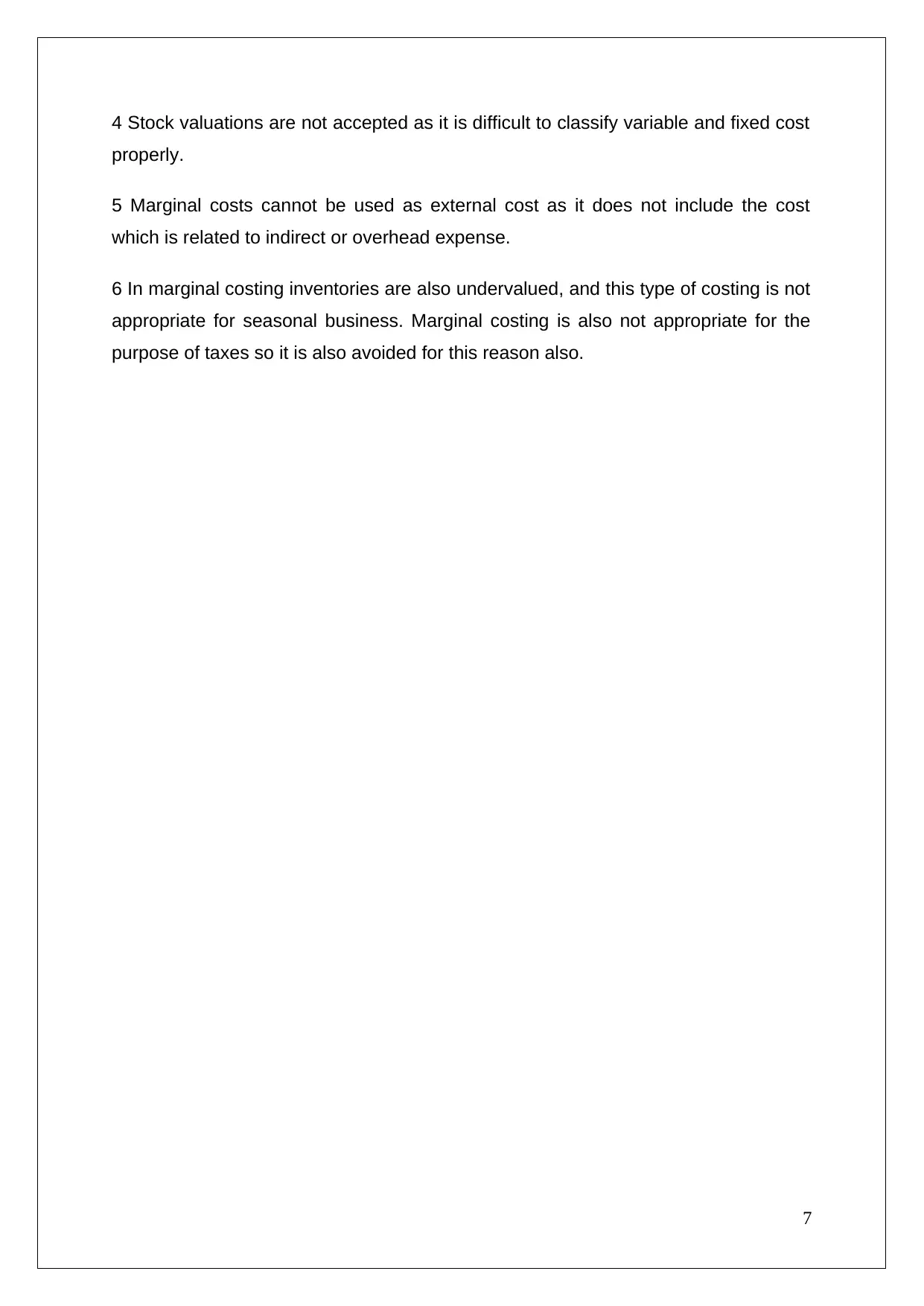
4 Stock valuations are not accepted as it is difficult to classify variable and fixed cost
properly.
5 Marginal costs cannot be used as external cost as it does not include the cost
which is related to indirect or overhead expense.
6 In marginal costing inventories are also undervalued, and this type of costing is not
appropriate for seasonal business. Marginal costing is also not appropriate for the
purpose of taxes so it is also avoided for this reason also.
7
properly.
5 Marginal costs cannot be used as external cost as it does not include the cost
which is related to indirect or overhead expense.
6 In marginal costing inventories are also undervalued, and this type of costing is not
appropriate for seasonal business. Marginal costing is also not appropriate for the
purpose of taxes so it is also avoided for this reason also.
7
Paraphrase This Document
Need a fresh take? Get an instant paraphrase of this document with our AI Paraphraser
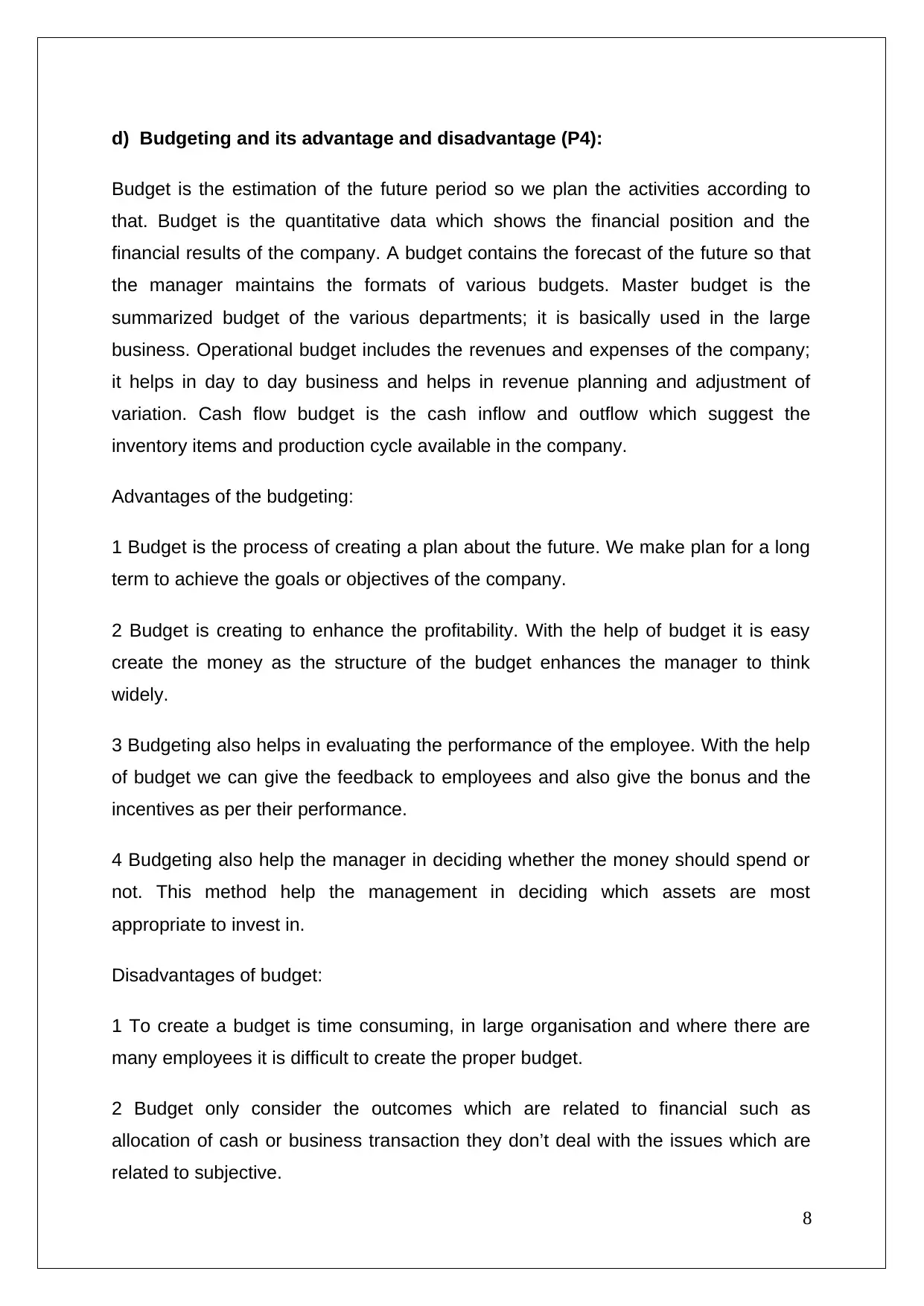
d) Budgeting and its advantage and disadvantage (P4):
Budget is the estimation of the future period so we plan the activities according to
that. Budget is the quantitative data which shows the financial position and the
financial results of the company. A budget contains the forecast of the future so that
the manager maintains the formats of various budgets. Master budget is the
summarized budget of the various departments; it is basically used in the large
business. Operational budget includes the revenues and expenses of the company;
it helps in day to day business and helps in revenue planning and adjustment of
variation. Cash flow budget is the cash inflow and outflow which suggest the
inventory items and production cycle available in the company.
Advantages of the budgeting:
1 Budget is the process of creating a plan about the future. We make plan for a long
term to achieve the goals or objectives of the company.
2 Budget is creating to enhance the profitability. With the help of budget it is easy
create the money as the structure of the budget enhances the manager to think
widely.
3 Budgeting also helps in evaluating the performance of the employee. With the help
of budget we can give the feedback to employees and also give the bonus and the
incentives as per their performance.
4 Budgeting also help the manager in deciding whether the money should spend or
not. This method help the management in deciding which assets are most
appropriate to invest in.
Disadvantages of budget:
1 To create a budget is time consuming, in large organisation and where there are
many employees it is difficult to create the proper budget.
2 Budget only consider the outcomes which are related to financial such as
allocation of cash or business transaction they don’t deal with the issues which are
related to subjective.
8
Budget is the estimation of the future period so we plan the activities according to
that. Budget is the quantitative data which shows the financial position and the
financial results of the company. A budget contains the forecast of the future so that
the manager maintains the formats of various budgets. Master budget is the
summarized budget of the various departments; it is basically used in the large
business. Operational budget includes the revenues and expenses of the company;
it helps in day to day business and helps in revenue planning and adjustment of
variation. Cash flow budget is the cash inflow and outflow which suggest the
inventory items and production cycle available in the company.
Advantages of the budgeting:
1 Budget is the process of creating a plan about the future. We make plan for a long
term to achieve the goals or objectives of the company.
2 Budget is creating to enhance the profitability. With the help of budget it is easy
create the money as the structure of the budget enhances the manager to think
widely.
3 Budgeting also helps in evaluating the performance of the employee. With the help
of budget we can give the feedback to employees and also give the bonus and the
incentives as per their performance.
4 Budgeting also help the manager in deciding whether the money should spend or
not. This method help the management in deciding which assets are most
appropriate to invest in.
Disadvantages of budget:
1 To create a budget is time consuming, in large organisation and where there are
many employees it is difficult to create the proper budget.
2 Budget only consider the outcomes which are related to financial such as
allocation of cash or business transaction they don’t deal with the issues which are
related to subjective.
8
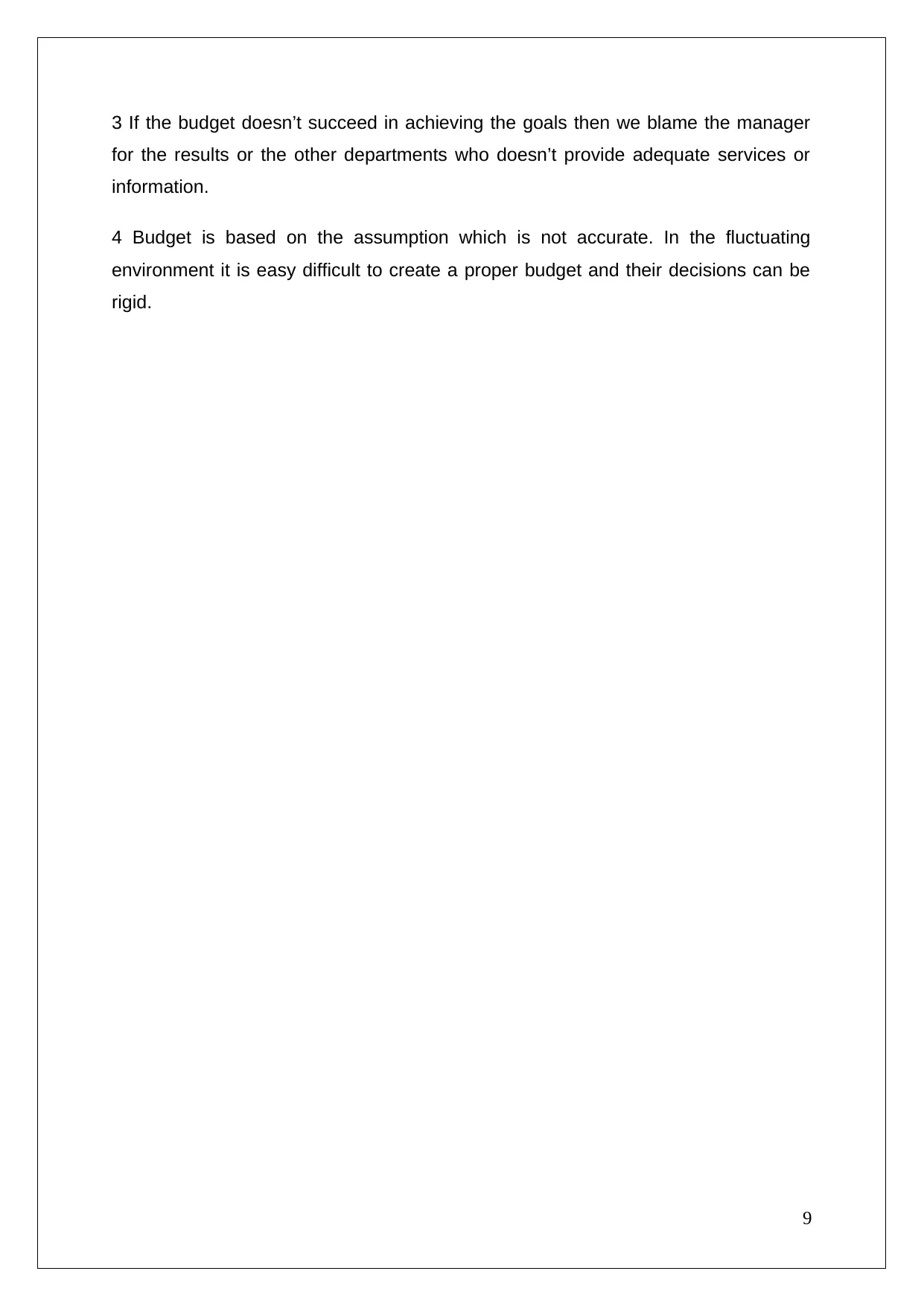
3 If the budget doesn’t succeed in achieving the goals then we blame the manager
for the results or the other departments who doesn’t provide adequate services or
information.
4 Budget is based on the assumption which is not accurate. In the fluctuating
environment it is easy difficult to create a proper budget and their decisions can be
rigid.
9
for the results or the other departments who doesn’t provide adequate services or
information.
4 Budget is based on the assumption which is not accurate. In the fluctuating
environment it is easy difficult to create a proper budget and their decisions can be
rigid.
9
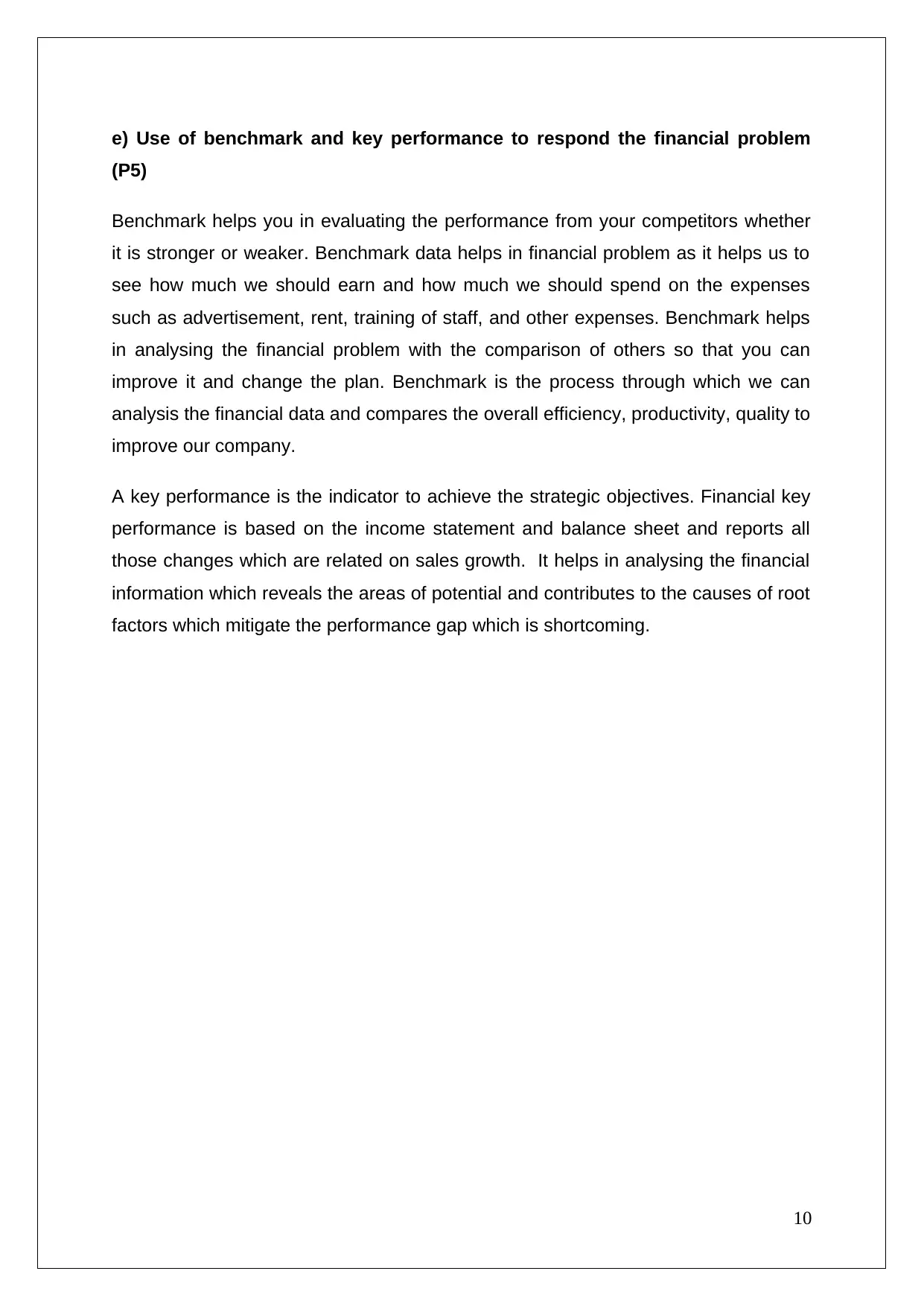
e) Use of benchmark and key performance to respond the financial problem
(P5)
Benchmark helps you in evaluating the performance from your competitors whether
it is stronger or weaker. Benchmark data helps in financial problem as it helps us to
see how much we should earn and how much we should spend on the expenses
such as advertisement, rent, training of staff, and other expenses. Benchmark helps
in analysing the financial problem with the comparison of others so that you can
improve it and change the plan. Benchmark is the process through which we can
analysis the financial data and compares the overall efficiency, productivity, quality to
improve our company.
A key performance is the indicator to achieve the strategic objectives. Financial key
performance is based on the income statement and balance sheet and reports all
those changes which are related on sales growth. It helps in analysing the financial
information which reveals the areas of potential and contributes to the causes of root
factors which mitigate the performance gap which is shortcoming.
10
(P5)
Benchmark helps you in evaluating the performance from your competitors whether
it is stronger or weaker. Benchmark data helps in financial problem as it helps us to
see how much we should earn and how much we should spend on the expenses
such as advertisement, rent, training of staff, and other expenses. Benchmark helps
in analysing the financial problem with the comparison of others so that you can
improve it and change the plan. Benchmark is the process through which we can
analysis the financial data and compares the overall efficiency, productivity, quality to
improve our company.
A key performance is the indicator to achieve the strategic objectives. Financial key
performance is based on the income statement and balance sheet and reports all
those changes which are related on sales growth. It helps in analysing the financial
information which reveals the areas of potential and contributes to the causes of root
factors which mitigate the performance gap which is shortcoming.
10
Secure Best Marks with AI Grader
Need help grading? Try our AI Grader for instant feedback on your assignments.
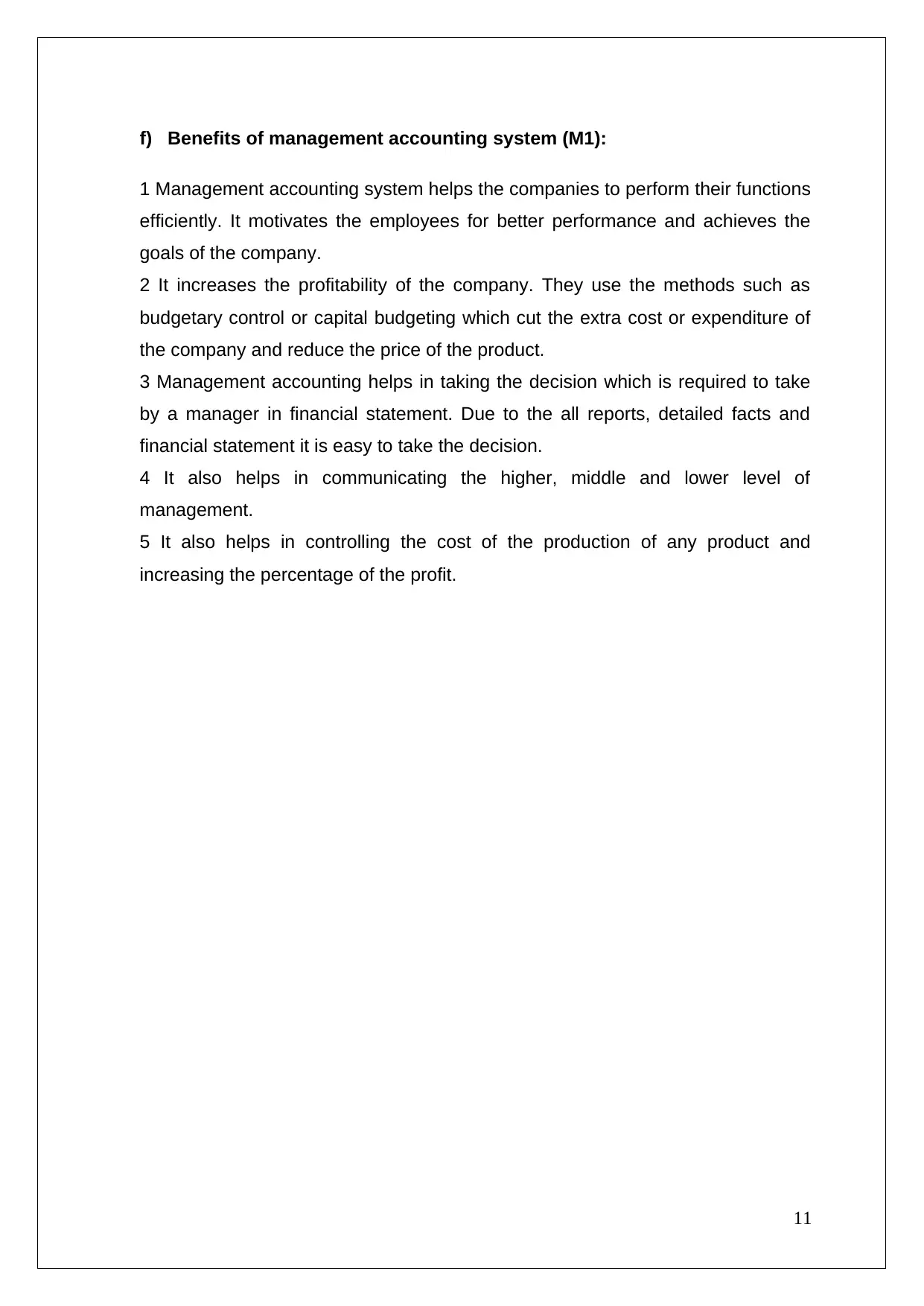
f) Benefits of management accounting system (M1):
1 Management accounting system helps the companies to perform their functions
efficiently. It motivates the employees for better performance and achieves the
goals of the company.
2 It increases the profitability of the company. They use the methods such as
budgetary control or capital budgeting which cut the extra cost or expenditure of
the company and reduce the price of the product.
3 Management accounting helps in taking the decision which is required to take
by a manager in financial statement. Due to the all reports, detailed facts and
financial statement it is easy to take the decision.
4 It also helps in communicating the higher, middle and lower level of
management.
5 It also helps in controlling the cost of the production of any product and
increasing the percentage of the profit.
11
1 Management accounting system helps the companies to perform their functions
efficiently. It motivates the employees for better performance and achieves the
goals of the company.
2 It increases the profitability of the company. They use the methods such as
budgetary control or capital budgeting which cut the extra cost or expenditure of
the company and reduce the price of the product.
3 Management accounting helps in taking the decision which is required to take
by a manager in financial statement. Due to the all reports, detailed facts and
financial statement it is easy to take the decision.
4 It also helps in communicating the higher, middle and lower level of
management.
5 It also helps in controlling the cost of the production of any product and
increasing the percentage of the profit.
11
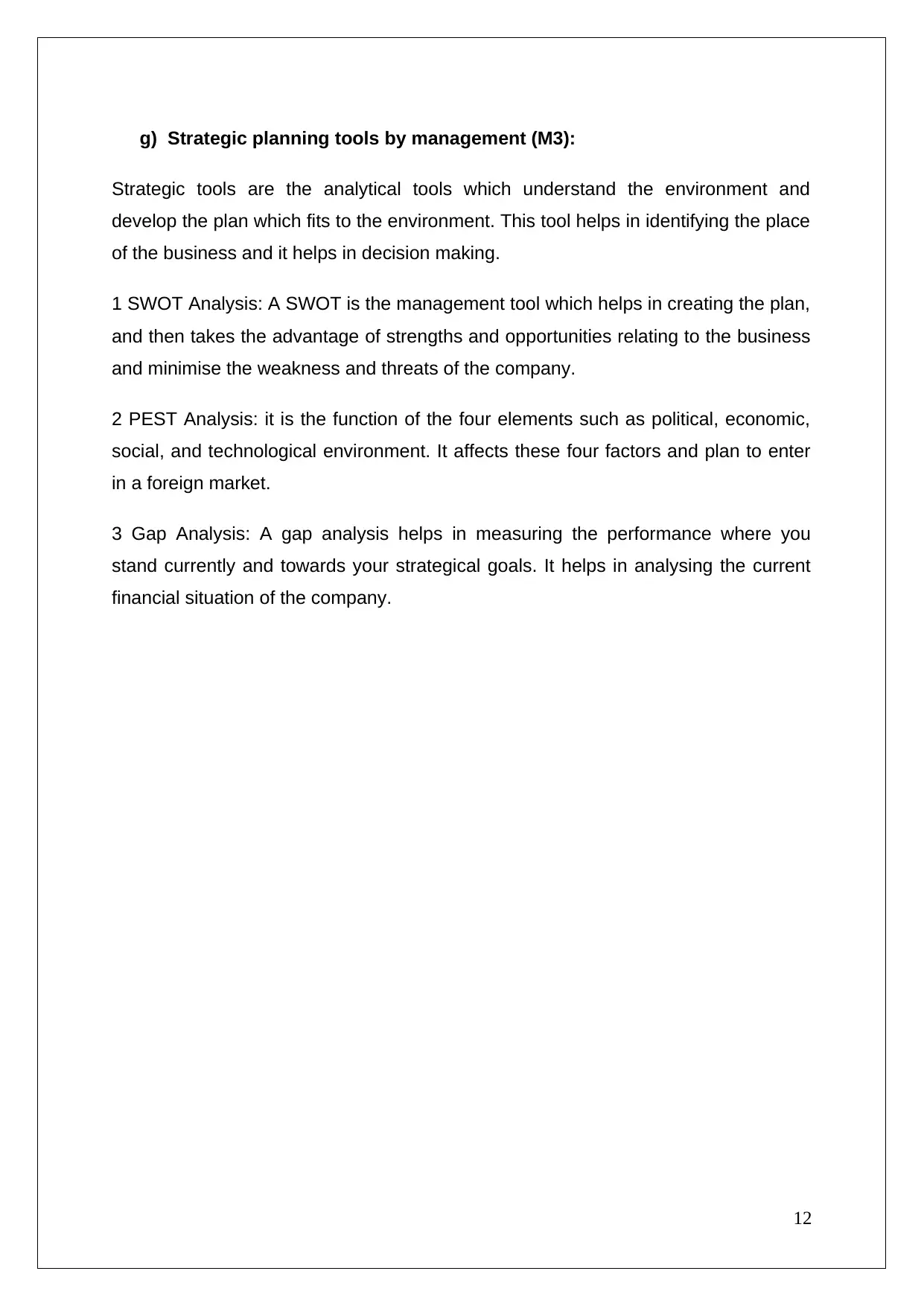
g) Strategic planning tools by management (M3):
Strategic tools are the analytical tools which understand the environment and
develop the plan which fits to the environment. This tool helps in identifying the place
of the business and it helps in decision making.
1 SWOT Analysis: A SWOT is the management tool which helps in creating the plan,
and then takes the advantage of strengths and opportunities relating to the business
and minimise the weakness and threats of the company.
2 PEST Analysis: it is the function of the four elements such as political, economic,
social, and technological environment. It affects these four factors and plan to enter
in a foreign market.
3 Gap Analysis: A gap analysis helps in measuring the performance where you
stand currently and towards your strategical goals. It helps in analysing the current
financial situation of the company.
12
Strategic tools are the analytical tools which understand the environment and
develop the plan which fits to the environment. This tool helps in identifying the place
of the business and it helps in decision making.
1 SWOT Analysis: A SWOT is the management tool which helps in creating the plan,
and then takes the advantage of strengths and opportunities relating to the business
and minimise the weakness and threats of the company.
2 PEST Analysis: it is the function of the four elements such as political, economic,
social, and technological environment. It affects these four factors and plan to enter
in a foreign market.
3 Gap Analysis: A gap analysis helps in measuring the performance where you
stand currently and towards your strategical goals. It helps in analysing the current
financial situation of the company.
12
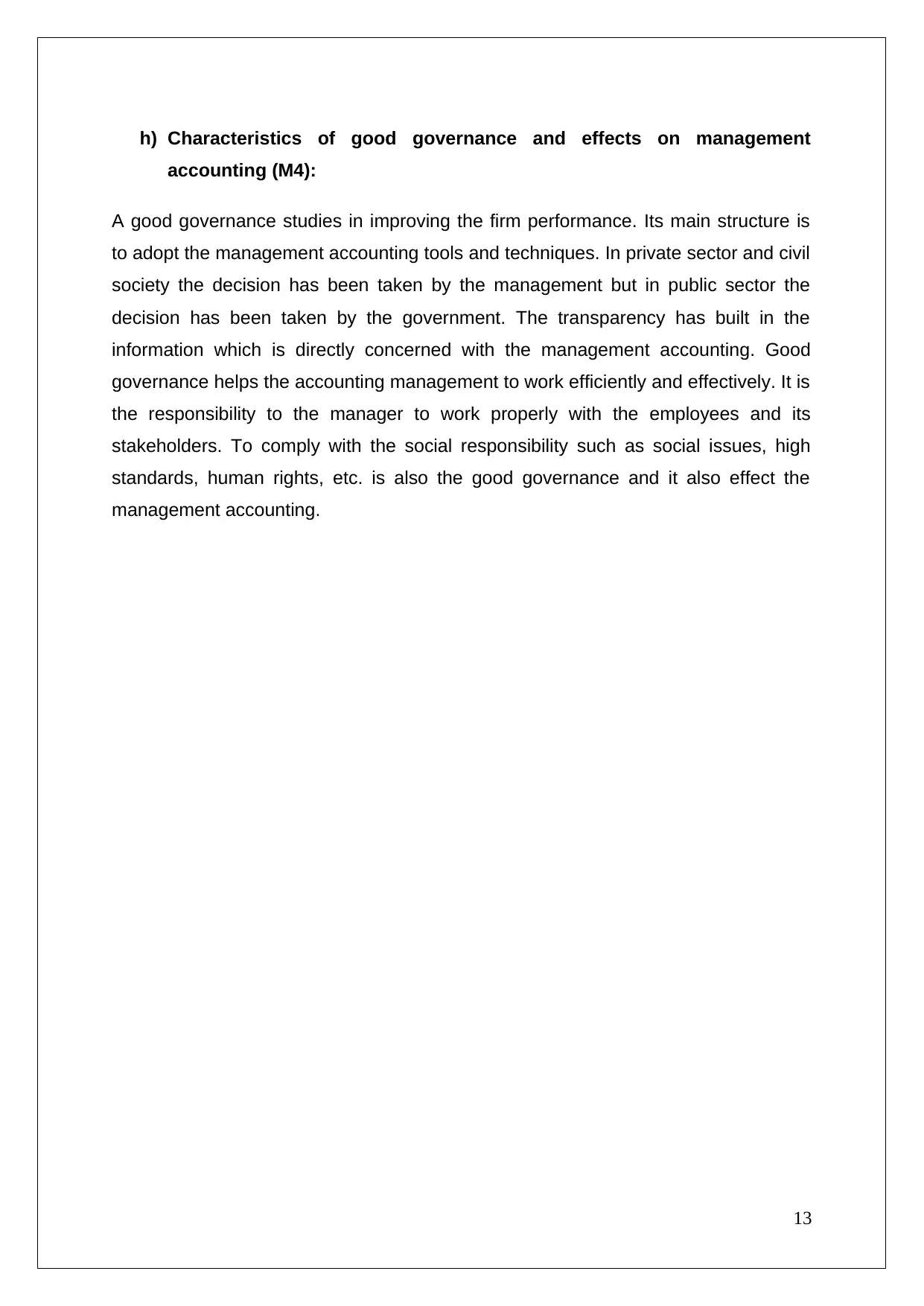
h) Characteristics of good governance and effects on management
accounting (M4):
A good governance studies in improving the firm performance. Its main structure is
to adopt the management accounting tools and techniques. In private sector and civil
society the decision has been taken by the management but in public sector the
decision has been taken by the government. The transparency has built in the
information which is directly concerned with the management accounting. Good
governance helps the accounting management to work efficiently and effectively. It is
the responsibility to the manager to work properly with the employees and its
stakeholders. To comply with the social responsibility such as social issues, high
standards, human rights, etc. is also the good governance and it also effect the
management accounting.
13
accounting (M4):
A good governance studies in improving the firm performance. Its main structure is
to adopt the management accounting tools and techniques. In private sector and civil
society the decision has been taken by the management but in public sector the
decision has been taken by the government. The transparency has built in the
information which is directly concerned with the management accounting. Good
governance helps the accounting management to work efficiently and effectively. It is
the responsibility to the manager to work properly with the employees and its
stakeholders. To comply with the social responsibility such as social issues, high
standards, human rights, etc. is also the good governance and it also effect the
management accounting.
13
Paraphrase This Document
Need a fresh take? Get an instant paraphrase of this document with our AI Paraphraser
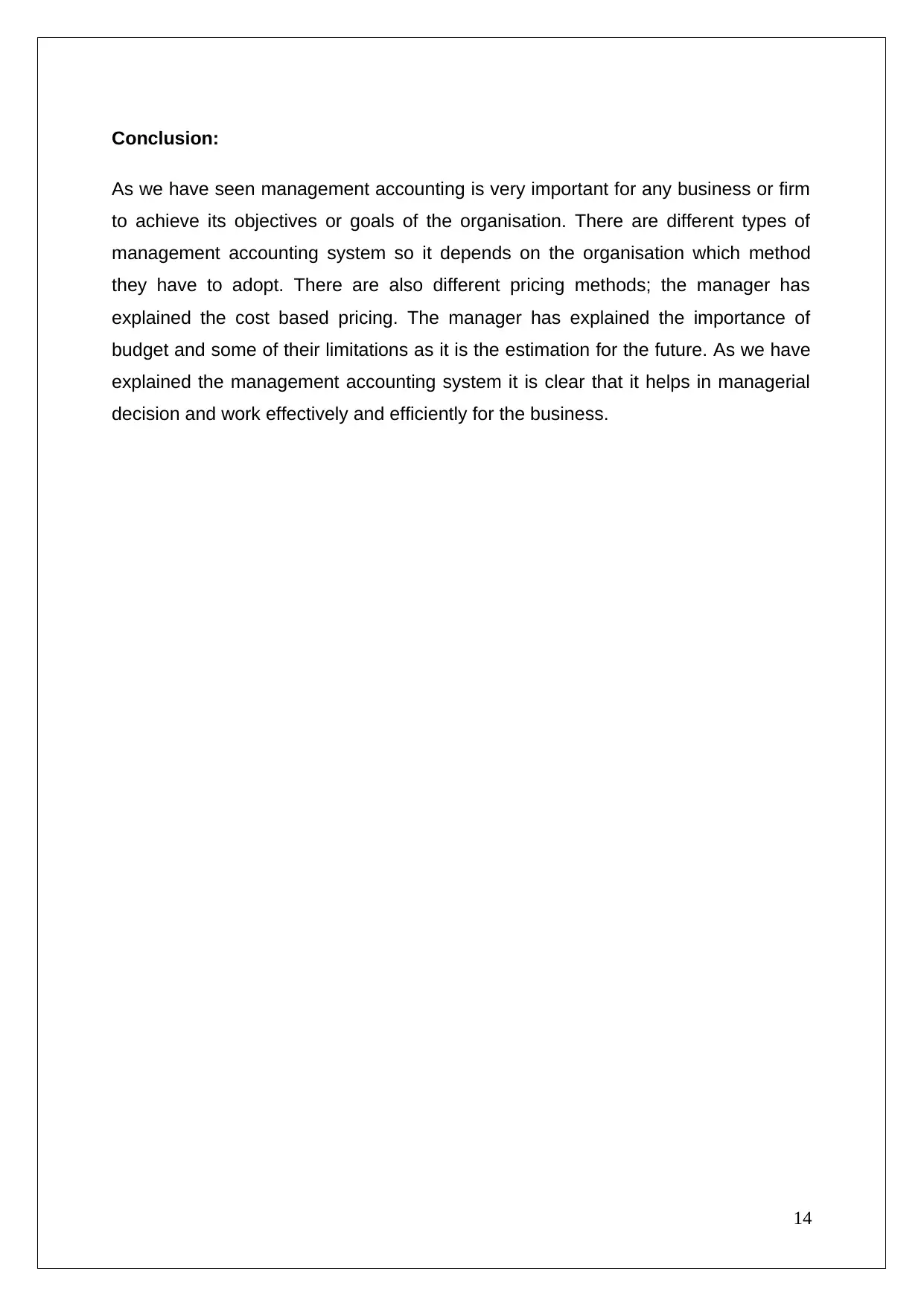
Conclusion:
As we have seen management accounting is very important for any business or firm
to achieve its objectives or goals of the organisation. There are different types of
management accounting system so it depends on the organisation which method
they have to adopt. There are also different pricing methods; the manager has
explained the cost based pricing. The manager has explained the importance of
budget and some of their limitations as it is the estimation for the future. As we have
explained the management accounting system it is clear that it helps in managerial
decision and work effectively and efficiently for the business.
14
As we have seen management accounting is very important for any business or firm
to achieve its objectives or goals of the organisation. There are different types of
management accounting system so it depends on the organisation which method
they have to adopt. There are also different pricing methods; the manager has
explained the cost based pricing. The manager has explained the importance of
budget and some of their limitations as it is the estimation for the future. As we have
explained the management accounting system it is clear that it helps in managerial
decision and work effectively and efficiently for the business.
14
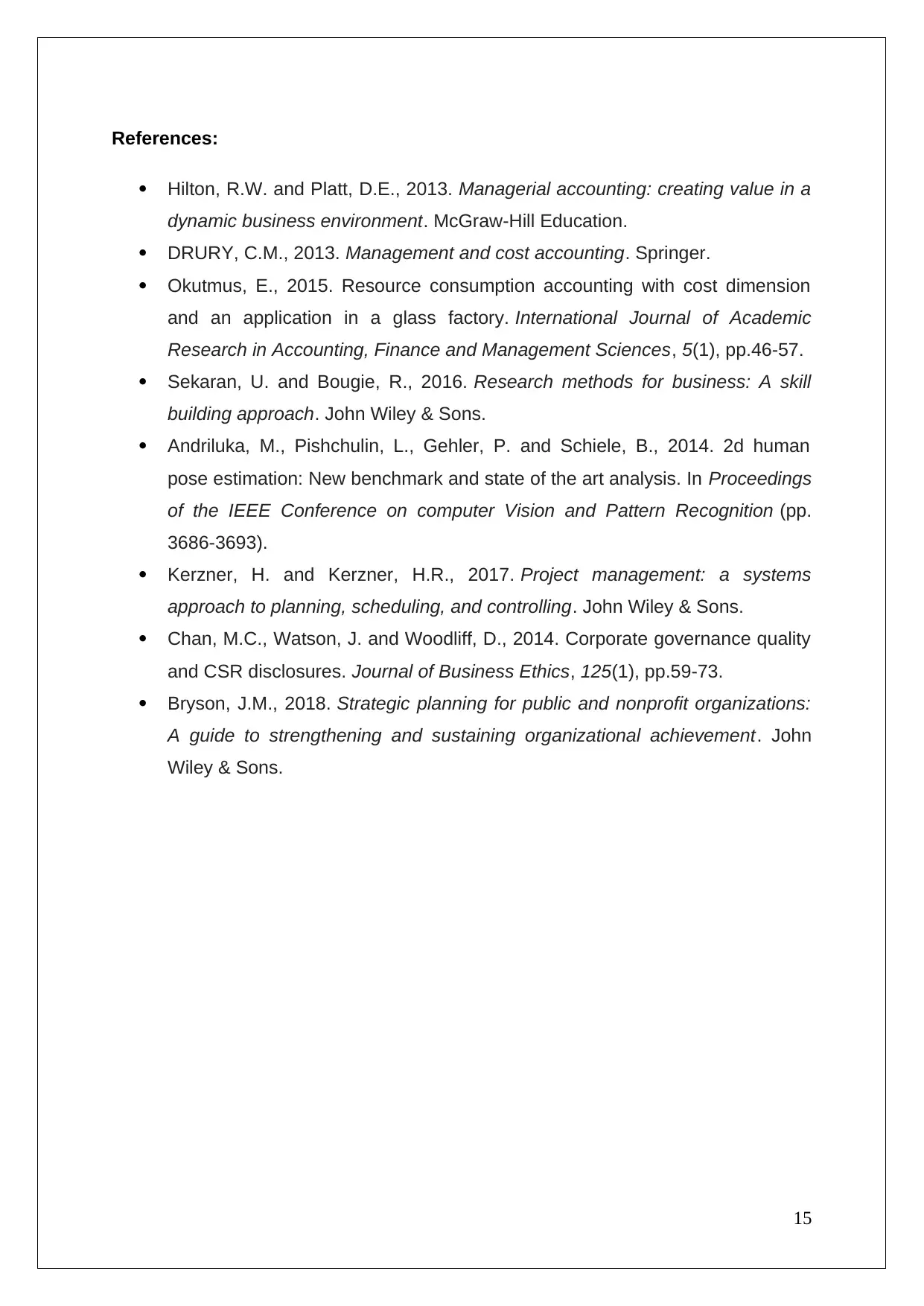
References:
Hilton, R.W. and Platt, D.E., 2013. Managerial accounting: creating value in a
dynamic business environment. McGraw-Hill Education.
DRURY, C.M., 2013. Management and cost accounting. Springer.
Okutmus, E., 2015. Resource consumption accounting with cost dimension
and an application in a glass factory. International Journal of Academic
Research in Accounting, Finance and Management Sciences, 5(1), pp.46-57.
Sekaran, U. and Bougie, R., 2016. Research methods for business: A skill
building approach. John Wiley & Sons.
Andriluka, M., Pishchulin, L., Gehler, P. and Schiele, B., 2014. 2d human
pose estimation: New benchmark and state of the art analysis. In Proceedings
of the IEEE Conference on computer Vision and Pattern Recognition (pp.
3686-3693).
Kerzner, H. and Kerzner, H.R., 2017. Project management: a systems
approach to planning, scheduling, and controlling. John Wiley & Sons.
Chan, M.C., Watson, J. and Woodliff, D., 2014. Corporate governance quality
and CSR disclosures. Journal of Business Ethics, 125(1), pp.59-73.
Bryson, J.M., 2018. Strategic planning for public and nonprofit organizations:
A guide to strengthening and sustaining organizational achievement. John
Wiley & Sons.
15
Hilton, R.W. and Platt, D.E., 2013. Managerial accounting: creating value in a
dynamic business environment. McGraw-Hill Education.
DRURY, C.M., 2013. Management and cost accounting. Springer.
Okutmus, E., 2015. Resource consumption accounting with cost dimension
and an application in a glass factory. International Journal of Academic
Research in Accounting, Finance and Management Sciences, 5(1), pp.46-57.
Sekaran, U. and Bougie, R., 2016. Research methods for business: A skill
building approach. John Wiley & Sons.
Andriluka, M., Pishchulin, L., Gehler, P. and Schiele, B., 2014. 2d human
pose estimation: New benchmark and state of the art analysis. In Proceedings
of the IEEE Conference on computer Vision and Pattern Recognition (pp.
3686-3693).
Kerzner, H. and Kerzner, H.R., 2017. Project management: a systems
approach to planning, scheduling, and controlling. John Wiley & Sons.
Chan, M.C., Watson, J. and Woodliff, D., 2014. Corporate governance quality
and CSR disclosures. Journal of Business Ethics, 125(1), pp.59-73.
Bryson, J.M., 2018. Strategic planning for public and nonprofit organizations:
A guide to strengthening and sustaining organizational achievement. John
Wiley & Sons.
15
1 out of 15
Related Documents
Your All-in-One AI-Powered Toolkit for Academic Success.
+13062052269
info@desklib.com
Available 24*7 on WhatsApp / Email
![[object Object]](/_next/static/media/star-bottom.7253800d.svg)
Unlock your academic potential
© 2024 | Zucol Services PVT LTD | All rights reserved.





